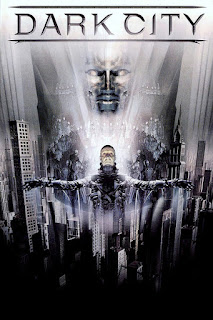DARK CITY (1998)
Directed by Alex Proyas
New Line Cinema, 111 minutes (director’s cut), R (nudity, language)
★★★★
Dark City dovetails with my recent interest in film noir, though it’s a newer sci-fi movie. It tanked in North American theaters, but has come in for reevaluation. Subsequently, elements of it made their way into works such as The Matrix and Inception. The latter copied Dark City’s trippy f/x effect of a city building itself in front of our eyes, an afflatus also borrowed by Amazon Studios.
Dark City has inspired comic books and spin-off novels, plus director and screenwriter Alex Proyas went on to direct I, Robot, which was a huge hit. It didn’t hurt that the late Roger Ebert declared Dark City the best film of 1998, or that it won major non-Oscar awards.
Is Dark City a noir film? Absolutely! There’s not a speck of light in it until the end and cinematographer Darius Adam Wolski manipulates shadows, incidental light, and nighttime with the skill of 1940s masters. It's a good thing, as the entire movie is set in darkness and external settings look like a moving version of Edward Hopper’s Nighthawks. Dark City also shares film noir’s penchant for murder mystery, though it might be more accurate to call the murders more of a subplot.
In brief, John Murdoch (Rufus Sewell) is an amnesiac who has no idea why he’s being pursued. As he attempts to piece together his identity, he learns that Inspector Frank Bumstead (William Hurt) has marked him the prime suspect in a series of Jack the Ripper-like murders of prostitutes. John’s wife Emma (Jennifer Connelly) hasn’t seen John in weeks, as he stormed out after learning that she had an affair.
So far, so normal, but it won’t stay that way. As a line in the movie puts it, “First there was darkness; then came the Strangers.” The latter are aliens manipulating humankind through a reluctant human intermediary, research scientist Dr. Daniel Scheher (Kiefer Sutherland). As we learn, it’s always dark because each midnight the aliens hold a “tuning.” As fast as you can “Shut it down!” everyone falls asleep, all transportation freezes to a halt, and the bald, black-cloaked aliens float from place-to-place exchanging memories and rearranging much of the city. For instance, one unkempt couple in a decrepit hovel awake to find themselves seated at a fancy table in a luxury apartment and have no recollection of having lived any other way. Injections to the front of the brain provide complete backstories.
Why? That’s what John wants to know. He literally doesn’t sleep, but unlike everyone else except Detective Eddie Walenski (Colin Friels), he remembers everything that happened since he last awoke. Whereas Walenski has gone ‘round the twist and is painting concentric circles everywhere, John is determined to find out if he’s actually a serial killer, why things grind to a halt a midnight, why the city shapeshifts, and why it’s always dark. He even escorts a hooker named May (Melissa George) and watches her undress to test whether he’s a murderer. He will learn about the Strangers from Scherer. Why are they doing all of this? It has something to do with wanting to unlock the secret of the soul, but I’ll leave it at that. Needless to say, John will be tasked with avoiding Bumstead and saving the city. If only he can find Shell Beach, he thinks he can do it.
That is, if reality is “real.” Dark City mixes enough speculative science with fiction to inspire interesting mind games. There is a reference to “Last Thursdayism,” a geek’s take on Creationist theory that postulates there is no objective way to prove that anything existed prior to what can be immediately perceived. And maybe there is no city at all; perhaps everyone is inside a Dyson sphere.
Dark City has been compared to Fritz Lang’s 1927 masterpiece Metropolis. I can see that, but it also borrows from Blade Runner (1982), Delicatessen (1991), The City of Lost Children (1995), and Star Trek’s Borg episodes. The Strangers are a lot like the Borg in that they exist as a hive mind, though Mr. Book (Ian Richardson) seems to be a male equivalent of a queen bee. Anticipate caper-like flights and f/x-infused showdowns.
If you don’t like science-fiction, you should avoid this movie. I found it stylish. gripping, and a really interesting non-conventional appropriation of film noir. Ebert was right; most Americans missed an outstanding movie.
Rob Weir

















